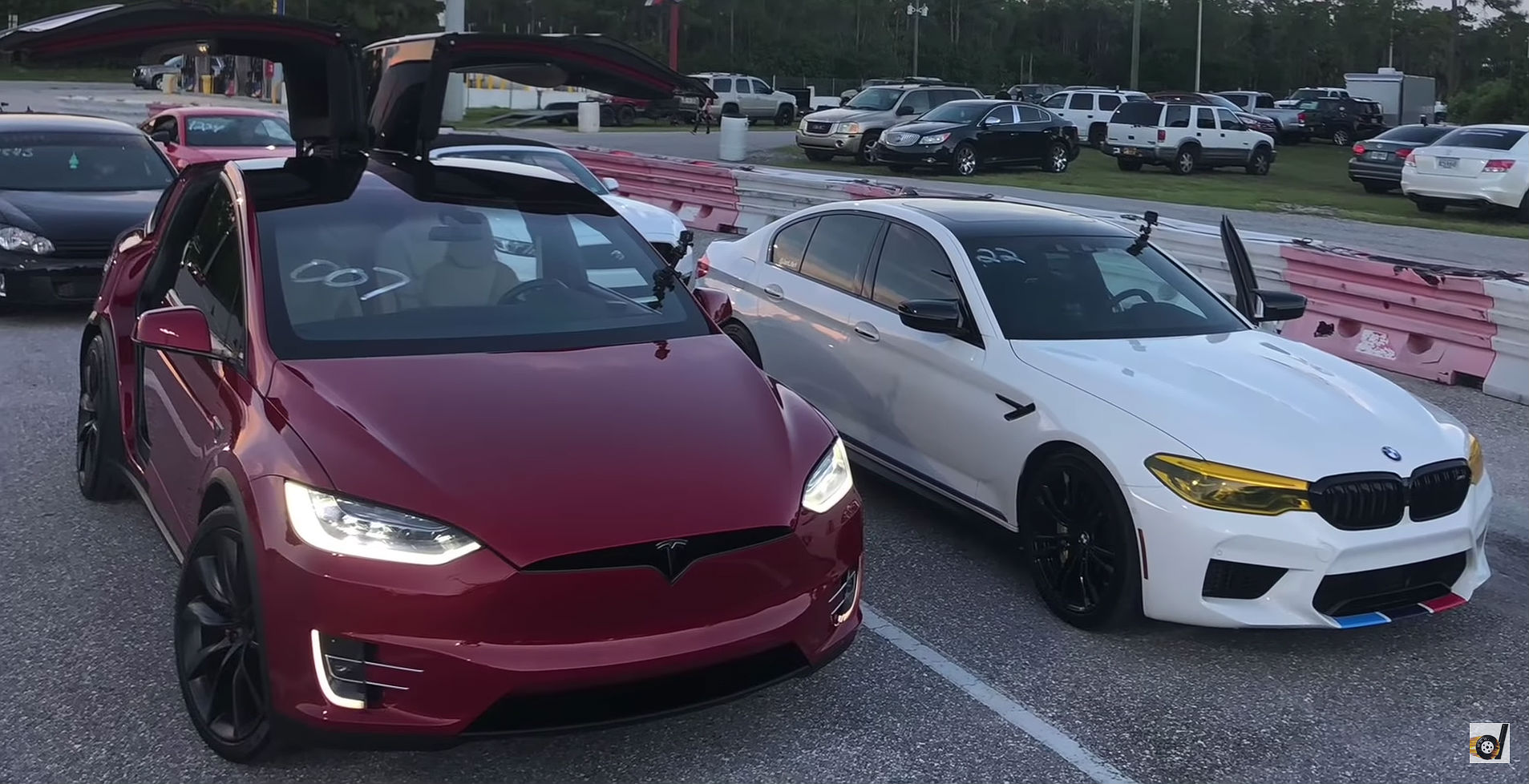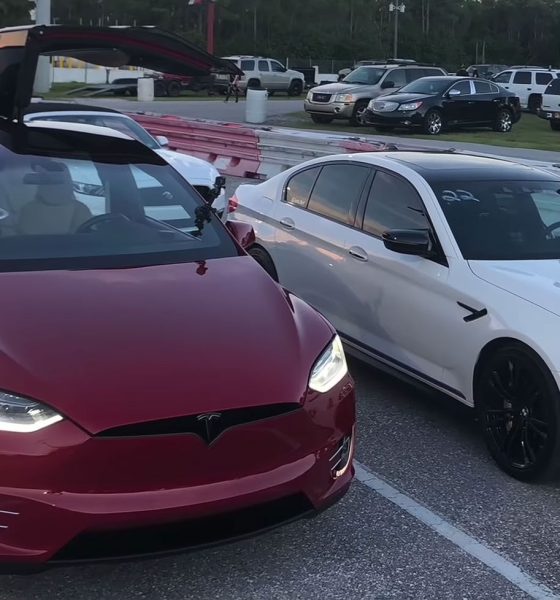

Lifestyle
Tesla Model S P100D and Model X P100D battle BMW M5 in tense 1/4-mile races
There are very few gas-powered sedans that are capable of standing toe-to-toe against the Tesla Model S P100D and the Model X P100D. Over the years, Tesla’s P100D twins have established themselves as formidable forces on the drag strip, with a long line of supercar victims under their belt. That said, when faced with Germany’s monster of a sedan — the 2018 BMW M5 — could the Model S P100D and Model X P100D still maintain their place as drag racing royalty?
Such a race was recently featured in YouTube’s DragTimes channel. The 2018 BMW M5 is pretty much the Model S’ gas-powered equivalent in the way that it is large, fast, and incredibly powerful. The M5 is equipped with a 4.4-liter V8 Twin Turbo engine that generates an impressive 617 hp and 553 ft-lb of torque. The car could be bought in either RWD or AWD configurations, though the vehicle in DragTimes‘ recent video was the all-wheel-drive version. The BMW M5 is pretty beefy at 4,370 lbs, but it is still quick, capable of going from 0-60 mph in 3.2 seconds. The M5 is listed with a top speed of 155 mph, but with the optional M Driver’s Package, the vehicle’s top speed gets raised to 189 mph.
In contrast, the Tesla Model S P100D is fitted with all-electric dual motors that produce 588 hp to its wheels and 920 lb-ft of instant torque. The electric car is AWD as well, and is quite hefty at 4,900 lbs. Thanks to the instant torque from its two all-electric motors, the Model S P100D is capable of sprinting from 0-60 mph in ~2.3 seconds with Ludicrous Mode, though its top speed is software limited to 155 mph. The Tesla Model X P100D, on the other hand, might be an incredibly heavy vehicle at 5,700 lbs, but it is still quick off the line. Thanks to its twin electric motors that produce 588 hp and 920 lb-ft of instant torque to its wheels, the Model X P100D is able to hit the 60 mph mark in 2.9 seconds.
The 2018 BMW is actually a very well-balanced car, but as shown in DragTimes‘ video, the vehicle fell just a little bit short in its attempts at taking down the P100D twins. It ran one race with the Model X P100D, where it finished the quarter mile in 11.35 seconds while traveling at 123.53 mph. Unfortunately for the M5, the Model X P100D was slightly quicker, crossing the quarter-mile mark in 11.33 seconds at 116.84 mph.
The 2018 BMW M5 competed against the Model S P100D twice, and on the first run, the gas-powered sedan actually managed to get a jump on the all-electric supercar killer. That said, it didn’t take long before the Model S’ instant torque allowed it to catch up to the M5 and maintain a slight lead until the end of the race. The first bout between the Model S P100D and the 2018 M5 was close overall, ending with the Tesla completing the race in 11.06 seconds at 118.86 mph and the BMW finishing the run in 11.27 seconds at 123.77 mph. The Model S P100D dominated the second race, crossing the quarter-mile mark in 10.98 seconds at 119.08 mph compared to the BMW M5’s 11.46 seconds at 120.94 mph.
The P100D twins are still Tesla’s quickest vehicles when it comes to straight-line races. That said, the Model 3 Performance, the latest iteration of the company’s midsize electric sedan, is looking to be formidable in an area where the Model S and X are still lacking — the track. The Model 3 Performance is even set to receive a dedicated Track Mode, an option that Elon Musk describes as an “Expert User Mode” for the vehicle.
Watch the Model S P100D and Model X P100D battle it out with the 2018 BMW M5 in the video below.

Lifestyle
Tesla Model S Plaid battles China’s 1500 hp monster Nurburgring monster, with surprising results
There is just something about Tesla’s tuning and refinement that makes raw specs seem not as game-changing.

The Tesla Model S Plaid has been around for some time. Today, it is no longer the world’s quickest four-door electric sedan, nor is it the most powerful. As per a recent video from motoring YouTube channel Carwow, however, it seems like the Model S Plaid is still more than a match for some of its newer and more powerful rivals.
The monster from China
The Xiaomi SU7 Ultra is nothing short of a monster. Just like the Model S Plaid, it features three motors. It also has 1,548 hp and 1,770 Nm of torque. It’s All Wheel Drive and weighs a hefty 2,360 kg. The vehicle, which costs just about the equivalent of £55,000, has been recorded setting an insane 7:04.957 at the Nurburgring, surpassing the previous record held by the Porsche Taycan Turbo GT.
For all intents and purposes, the Model S Plaid looked outgunned in Carwow’s test. The Model S Plaid is no slouch with its three motors that produce 1,020 hp and 1,420 Nm of torque. It’s also a bit lighter at 2,190 kg despite its larger size. However, as the Carwow host pointed out, the Model S Plaid holds a 7:25.231 record in the Nurburgring. Compared to the Xiaomi SU7 Ultra’s record, the Model S Plaid’s lap time is notably slower.
Real-world tests
As could be seen in Carwow’s drag races, however, Tesla’s tech wizardry with the Model S Plaid is still hard to beat. The two vehicles competed in nine races, and the older Model S Plaid actually beat its newer, more powerful counterpart from China several times. At one point in the race, the Xiaomi SU7 Ultra hit its power limit due to its battery’s temperature, but the Model S Plaid was still going strong.
The Model S Plaid was first teased five years ago, in September 2020 during Tesla’s Battery Day. Since then, cars like the Lucid Air Sapphire and the Xiaomi SU7 Ultra have been released, surpassing its specs. But just like the Model Y ended up being the better all-rounder compared to the BYD Sealion 7 and the MG IM6, there is just something about Tesla’s tuning and refinement that makes raw specs seem not as game-changing.
Check out Carwow’s Model S Plaid vs Xiaomi SU7 drag race video below.
Lifestyle
500-mile test proves why Tesla Model Y still humiliates rivals in Europe
On paper, the BYD Sealion 7 and MG IM6 promised standout capabilities against the Model Y.

BYD is seeing a lot of momentum in Europe, so much so that mainstream media has taken every opportunity to argue that the Chinese automaker has beaten Tesla in the region. But while BYD sales this year in Europe are rising and Tesla’s registrations remain challenged, the raw capabilities of vehicles like the Model Y are difficult to deny.
This was highlighted in a 500-mile challenge by What Car? magazine, which showed that the new Tesla Model Y is more efficient, cheaper to run, and more reliable than rivals like the BYD Sealion 7, and even the nearly 400 KW-charging MG IM6.
Range and charging promises
On paper, the BYD Sealion 7 and MG IM6 promised standout capabilities against the Model Y. The Sealion 7 had more estimated range and the IM6 promised significantly faster charging. When faced with real-world conditions, however, it was still the Model Y that proved superior.
During the 500-mile test, the BYD nearly failed to reach a charging stop, arriving with less range than its display projected, as noted in a CarUp report. MG fared better, but its charging speeds never reached its promised nearly-400 kW charging speed. Tesla’s Model Y, by comparison, managed energy calculations precisely and arrived at each stop without issue.
Tesla leads in areas that matter
Charging times from 25% to 80% showed that the MG was the fastest at 17 minutes, while Tesla and BYD were close at 28 and 29 minutes, respectively. Overall efficiency and cost told a different story, however. The Model Y consumed 19.4 kWh per 100 km, compared to 22.2 for MG and 23.9 for BYD. Over the full trip, Tesla’s charging costs totaled just £82 thanks to its supercharger network, far below BYD’s £130 and MG’s £119.
What Car? Magazine’s testers concluded that despite BYD’s rapid sales growth and the MG IM6’s seriously impressive charging speeds, Tesla remains the more compelling real-world choice. The Model Y just offers stability, efficiency, and a proven charging infrastructure through its Supercharging network. And as per the magazine’s hosts, the Model Y is even the cheapest car to own among the three that were tested.
Watch What Car? Magazine’s 500-mile test in the video below.
Lifestyle
Tesla Cybertruck slapped with world’s least intimidating ticket, and it’s pure cringe
One cannot help but cringe and feel second-hand embarrassment at the idea of a person just driving around with a stack of these babies.

A Cybertruck parked at Stanford Shopping Center in California was recently hit with what might be the most try-hard piece of paper ever slipped under a wiper blade: a “fake citation” accusing the driver of supporting a “fascist car.”
The note, shared on X by Tesla staff program manager Ryan Torres, quickly made the rounds on X, where it quickly gained attention as an example of how not to protest.
The world’s least intimidating ticket
According to the citation, the supposed “violation” was “driving a fascist car.” The remedial action? Take the bus, call an Uber, or ride a bike. The note also dubbed Elon Musk a “chainsaw-wielding Nazi billionaire.” Now, protests against Tesla and Elon Musk have become commonplace this year, but one cannot help but cringe and feel second-hand embarrassment at the idea of a person just driving around with a stack of fake anti-Tesla/Musk citations.
Torres pointed out the irony himself in his post on X. Tesla currently employs over 140,000 Americans, and SpaceX has put the U.S. firmly back at the top of space technology. As Torres put it, maybe the person behind the world’s least intimidating ticket should “read a book on innovation before vandalizing” other people’s property.
Peak performative clownery
Not to mention that the fake ticket’s logic collapses under its own weight. EVs like the Cybertruck are literally designed to reduce emissions, not “destroy the economy.” If anything, Tesla has bolstered the United States’ economy by fueling jobs in engineering, manufacturing, and clean energy. It’s not the first time a Tesla has been the target of vandalism or politically charged notes, but this one stands out for sheer cringe value.
Torres summed it up neatly: “Peak clownery.” On that point, at least, the citation earns full marks. In a way, though, perhaps cringe fake tickets are not as bad as the literal firebombs that were being thrown at Tesla stores and cars earlier this year because some critics were gleefully misinformed about Elon Musk.








